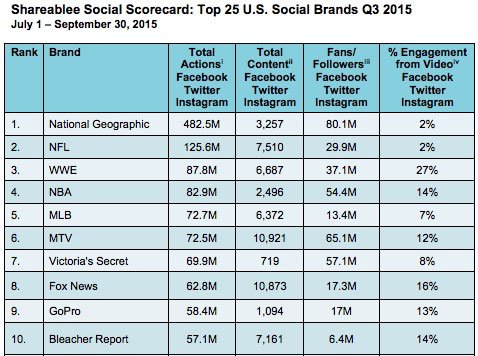National Geographic was ranked the number 1 brand on social media for the third quarter of 2015, according to data from Shareablee that analyzed the total consumer engagement on Facebook, Twitter and Instagram.

Do these results surprise you? Probably not when you think of the stunning visual content and interesting articles from National Geographic that translates so well to social media. Let’s stop and take a minute to ooh and ahh over the beautiful photography we have come to know and love from Nat Geo, shall we?
Ooohh…
Photo of the Day: Canyon River http://t.co/oCZ15OYGrt #photography #pod
— National Geographic (@NatGeo) October 5, 2015Ahhhh…
Ok, that’s enough. Back to the actual reason we’re talking about National Geographic… their winning social scorecard.
Even if your company doesn’t receive anywhere close to millions of social media interactions per quarter, or ever, Shareablee’s engagement ranking can help us begin to evaluate your engagement and even your competitors’. Engagement is a statistic all marketers need to pay attention to and the significance of this metric on your online marketing efforts is only increasing. For example, with the recent Google algorithm update, Google is placing more emphasis on your brand’s social interactions with your audience via sharing sites, review sites, forums, blog comments, etc., when ranking your website in search.
So how do you begin to track engagement? With the abundance of social media and web analytics at our fingertips, it can be confusing to know which statistics are relevant to measure. Here are some tools and just a few key stats to watch in order to evaluate your company’s social media engagement.
There is a LOT of information available through Facebook Insights, the native analytics tools Facebook page administrators can access. To keep it simple, the main engagement metrics to track for Facebook are likes, comments and shares. From there, it is helpful to calculate your engagement rate of each specific action per post (i.e. likes/post, comments/post, shares/post) to see trends over time. For example, if your goal is to increase website traffic from Facebook, track your Facebook engagement rate against your web traffic to see the correlation. Then determine an engagement rate you’d like to achieve on a monthly or quarterly basis to reach your web traffic goal.
You can take the same approach for Twitter with its native tool, Twitter Analytics, and view correlating engagement metrics of favorites, replies and retweets to generate an engagement rate per tweet. Then, just like the Facebook example, you can track engagement rate against your blog or web traffic to see how your Twitter activity impacts your site traffic.
Instagram is a bit different if we stick with the same example of engagement vs. site traffic because Instagram posts don’t include a link in the post. Instagram is a photo/video platform that users can like and comment on but only visit your website from the profile bio. However, there are a few different tools that can measure engagement on Instagram and the comparable engagement metrics to note are likes and comments, which you can also count manually to start.
No matter your online marketing goal (website traffic, contact form submissions, downloads, video views, etc.), the importance of social media is increasing and engagement is a key measurement of content success. While the numbers you collect may not tell a story right away, trends will begin to appear over time and you can adjust your social media content strategy accordingly. If you need help setting up your company’s social media engagement report card, contact our social media experts!
© Insight Creative, Inc. All rights reserved.